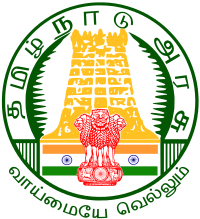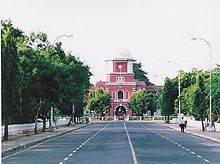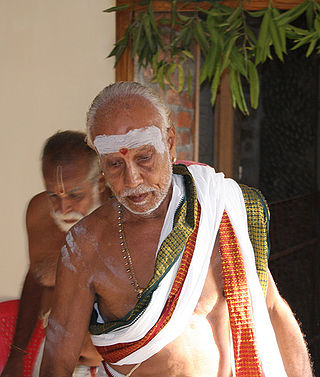
Iyers are an ethnoreligious community of Tamil-speaking Brahmins. Most Iyers are followers of the Advaita philosophy propounded by Adi Shankara and adhere to the Smarta tradition. This is in contrast to the Iyengar community, who are adherents of Sri Vaishnavism. The Iyers and the Iyengars are together referred to as Tamil Brahmins. The majority of Iyers reside in Tamil Nadu, India.

Syama Sastri or Shyama Shastri was a musician and composer of Carnatic music. He was the oldest among the Trinity of Carnatic music, Tyagaraja and Muthuswami Dikshitar being the other two.
Niyogi Brahmin is a Telugu Brahmin subcaste native to the Indian states of Andhra Pradesh and Telangana, but are spread throughout South India and Maharashtra. The traditional occupations of the Niyogi Brahmins are settled cultivation and priesthood. But majority of them took up various secular vocations including military activities and karanams. They were associated with administration, economics, literature, music composing, politics, scholarly, scientific, engineering, defense and warfare careers.

Parangimalai is a small hillock in the Chennai district of Tamil Nadu, India, near the neighbourhood of Guindy and very close to Chennai International Airport. By extension, it is also the name of the neighbourhood surrounding the hillock.
Deshastha Brahmin is a Hindu Brahmin subcaste mainly from the Indian state of Maharashtra and North Karnataka. Other than these states, according to authors K. S. Singh, Gregory Naik and Pran Nath Chopra, Deshastha Brahmins are also concentrated in the states of Telangana (which was earlier part of Hyderabad State and Berar Division), Andhra Pradesh and Madhya Pradesh (Which was earlier part of Central Provinces and Berar) Historian Pran Nath Chopra and journalist Pritish Nandy say, "Most of the well-known saints from Maharashtra, Karnataka and Andhra Pradesh were Deshastha Brahmins". The mother tongue of Deshastha Brahmins is either Marathi, Kannada or Telugu.
Anti-Brahminism is a term used in opposition to caste based hierarchal social order which places Brahmins at its highest position. Initial expressions of Anti-Brahminism emerged from instances of pre-colonial opposition to the caste system in India, ideological influences during the colonial period, and from a colonialist Protestant Christian understanding of religion in the 19th century, which viewed "Brahminism" as a corrupted religion imposed on the Indian population.

The Nambudiri, also transliterated as Nampoothiri, Nambūdiri, Namboodiri, Namboothiri and Nampūtiri, are a Malayali Brahmin caste, native to what is now the state of Kerala, India, where they constituted part of the traditional feudal elite. Headed by the Azhvanchery Thamprakkal Samrāṭ, the Nambudiris were the highest ranking caste in Kerala. They owned a large portion of the land in the region of Malabar District, and together with the Nair monarchs of Kerala, the Nambudiris formed the landed aristocracy known as the Jenmimar, until the Kerala Land Reforms starting in 1957.
Vadama, meaning "Northerners", are a sub-sect of the Iyer community of Tamil Brahmins. While some believe that their name is an indication of the fact that they were the most recent Brahmin migrants to the Tamil country others interpret the usage of the term "Vadama" as a reference to their strict adherence to the Sanskrit language and Vedic rituals which are of northerly origin.
The Secondary School Leaving Certificate is a certification obtained by a student on successful completion of an examination at the end of study at the secondary schooling level in India. The SSLC is obtained on passing the grade 10 public examination, which is commonly referred to as 'class 10 board examinations' in India. SSLC is a common eligibility examination popular in many states in India, especially Kerala, Karnataka, and Tamil Nadu. The SSLC is also called Secondary School Certificate (SSC) in Andhra Pradesh, Telangana, Maharashtra and also as High School Certificate (HSC) in Madhya Pradesh and also as Matriculation in many states of India.
Higher Secondary Certificate (HSC), Higher Secondary School Certificate, Higher Secondary Education Certificate (HSEC) or Intermediate Examination is a secondary education qualification in Bangladesh, India and Pakistan. It is equivalent to the final year of high school in the United States and A level in the United Kingdom.
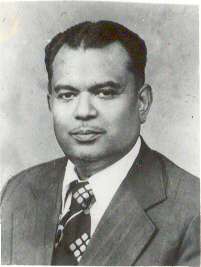
Harris Sam Sahayam Lawrence was an Indian educationalist born in Nagercoil, Tamil Nadu.

Periyar E. V. Ramasamy, also known as Ramaswami, EVR, Thanthai Periyar, or Periyar, was a Dravidian social reformer and politician from India, who founded the Self-Respect Movement and Dravidar Kazhagam. In 1919 Periyar Ramaswamy joined the Indian National Congress after quitting his business and resigning from public posts. He was the chairman of Erode Municipality and undertook Constructive Programs spreading the use of Khadi, picketing toddy shops, boycotting shops selling foreign cloth, and eradicating untouchability. In 1921, Periyar was imprisoned for picketing toddy shops in Erode. When his wife as well as his sister joined the agitation, it gained momentum, and the administration was forced to come to a compromise. He was again arrested during the Non-Cooperation movement and the Temperance movement. In 1922, Periyar was elected the President of the Madras Presidency Congress Committee during the Tirupur session where he advocated strongly for reservation in government jobs and education. His attempts were defeated in the Congress party due to a strong presence of discrimination and indifference. He later quit the party on those grounds in 1925.
Ashtasahasram is a sub-sect of the Iyer community of Tamil Brahmins from the Indian state of Tamil Nadu.
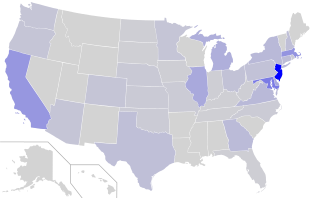
Tamil Americans are Americans who are of Tamil origin. The majority of Tamil Americans come from the Indian state of Tamil Nadu. Significant minorities are from other Indian states like Karnataka, Kerala, Andhra Pradesh, etc., as well as from other countries like Sri Lanka, Malaysia, and Singapore.

The Department of Higher Education is one of the departments of Government of Tamil Nadu. Established in 1997, the department is responsible for formulating policies and regulations for higher education in the state.
Christopher John Fuller is an emeritus professor of anthropology at the London School of Economics and a Fellow of the British Academy. He has studied and written extensively about the people of India, particularly with regard to subjects such as Hinduism, the caste system, and the relationship between globalisation and the middle-classes.

The Department of School Education is one of the departments of Government of Tamil Nadu.

The Vembaukum or Vembakkam family were one of the two preeminent Brahmin dynasties in the Madras Presidency, dominating the Mylapore clique alongside the Calamur clan, and 'possess(ing) an enormous presence in the... bureaucracy of the capital and its surrounding district(s)', whose historical presence began in the 1820s, with the sprawling clan famously having begun holding yearly family conferences by the 1890s to preserve their dynastic unity, political cohesion and influence, and wealth.
